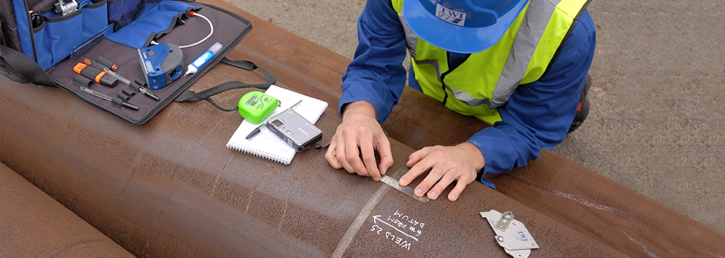Checking Out Advanced Tools and Techniques for Accurate Welding Examination
In the realm of welding assessment, the quest of precision and dependability is critical, stimulating the advancement of advanced devices and approaches. Laser scanning developments and computerized assessment systems, geared up with fabricated knowledge, are redefining the landscape by decreasing human mistake and improving safety and security procedures.
Ultrasonic Examining Developments
Ultrasonic testing technologies often stand for the forefront of innovations in welding evaluation innovations. These technologies have dramatically boosted the capability to detect and assess interruptions within bonded structures, making sure enhanced stability and security.

Furthermore, improvements in software application formulas for data evaluation have boosted the accuracy of issue detection and sizing. Automated ultrasonic screening systems now supply high-resolution imaging, allowing detailed evaluations of weld quality. These systems are usually integrated with sophisticated visualization tools, which promote the interpretation of outcomes.
Radiographic Evaluation Techniques
While ultrasonic screening developments have actually set a high criterion in non-destructive evaluation, radiographic inspection techniques remain to play an essential duty in welding examination by providing special understandings into material stability. Radiographic testing (RT) uses making use of X-rays or gamma rays to penetrate materials, producing a radiograph that aesthetically stands for the inner framework of a weld. This imaging capacity is indispensable for finding subsurface issues such as porosity, inclusions, and cracks that may not show up with surface assessments.
The procedure includes putting a radiation resource on one side of the weld and a detector on the opposite side. Variations in material thickness and density impact the attenuation of the rays, creating a different picture that exactly delineates defects. RT is particularly advantageous for inspecting thick sections and intricate geometries where other techniques may fall short.
Regardless of its performance, radiographic examination has to be performed with stringent adherence to safety protocols due to the dangerous nature of ionizing radiation. The analysis of radiographs requires skilled employees, as the high quality of the analysis straight impacts the integrity of the assessment. Continuous innovations in digital radiography are boosting image quality and interpretation effectiveness, reinforcing RT's essential function in making certain weld high quality.
Laser Scanning Advances
Welcoming laser scanning technology in welding assessment has actually revolutionized the analysis of weld quality and honesty. Unlike standard inspection techniques, laser scanning gives fast data procurement, dramatically improving the efficiency and precision of weld examinations.
Laser scanning developments have caused substantial renovations in identifying and finding surface defects such as porosity, absence of fusion, and undercuts. The high-resolution data allows assessors to do extensive analyses, ensuring that welds meet strict industry standards. Furthermore, this technique supports the growth of digital documents, promoting long-lasting high quality assurance and traceability.
In addition, laser scanning innovation integrates flawlessly with software program services designed for automated defect discovery and assessment. The resultant information can be easily shared and reviewed, advertising collaborative decision-making procedures. As markets remain to demand greater standards anchor for weld top quality, laser scanning remains at the center, providing unrivaled accuracy and efficiency in welding evaluation.
Automated Examination Solutions

Automated assessment systems use the benefit of consistency, removing human mistake and subjectivity from the evaluation process. They are made to operate in various settings, from manufacturing floorings to remote field websites, making certain comprehensive coverage. Welding Inspection Madison. These systems can be programmed to stick to particular welding requirements and requirements, giving detailed records and paperwork for top quality control purposes
Moreover, the assimilation of cloud-based platforms facilitates the storage and analysis of substantial amounts of evaluation data. This enables pattern evaluation and predictive upkeep, allowing suppliers to deal with possible issues prior to they rise. The adoption of automatic inspection systems is an essential move in the direction of improving the integrity and efficiency of welding processes in industrial applications.

Enhancing Safety and Effectiveness
A substantial facet of boosting safety and security and performance in welding inspection hinges on the integration of innovative technologies that streamline procedures and mitigate threats. The fostering of advanced non-destructive testing (NDT) methods, such as ultrasonic testing, phased array ultrasonic testing (PAUT), and radiographic screening, plays a crucial duty in making certain architectural stability without endangering the safety and security of the personnel involved. These techniques enable detailed assessments with marginal downtime, reducing possible dangers related to standard techniques.
Additionally, the application of real-time information analytics and device learning formulas has transformed the method inspection information is analyzed. By employing anticipating analytics, prospective defects can be recognized before they show up into crucial failings, making sure timely treatments and maintenance. This aggressive method significantly improves operational best site effectiveness and safety in welding procedures.
Additionally, remote evaluation modern technologies, including drones and robotic spiders equipped with high-resolution video cameras, make it possible for inspectors to examine hard-to-reach locations without subjecting them to unsafe conditions. This not only enhances examination precision but also lessens human threat. By leveraging these innovative tools and methods, markets can accomplish greater safety and security criteria and operational efficiency, ultimately leading to more trustworthy and lasting welding inspection techniques.
Conclusion
The assimilation of sophisticated tools and methods in welding assessment considerably enhances defect discovery and makes sure structural honesty. These advancements not only raise examination performance however likewise contribute to enhanced safety and security and top quality assurance in industrial welding applications.

Ultrasonic testing technologies regularly stand moved here for the center of improvements in welding evaluation innovations.While ultrasonic screening advancements have actually established a high requirement in non-destructive exam, radiographic evaluation methods continue to play an essential role in welding inspection by supplying distinct insights right into product integrity.Accepting laser scanning innovation in welding examination has transformed the evaluation of weld top quality and integrity. As industries continue to require greater criteria for weld quality, laser scanning stays at the leading edge, supplying exceptional accuracy and performance in welding inspection.
Automated assessment systems supply the advantage of consistency, getting rid of human mistake and subjectivity from the examination process.